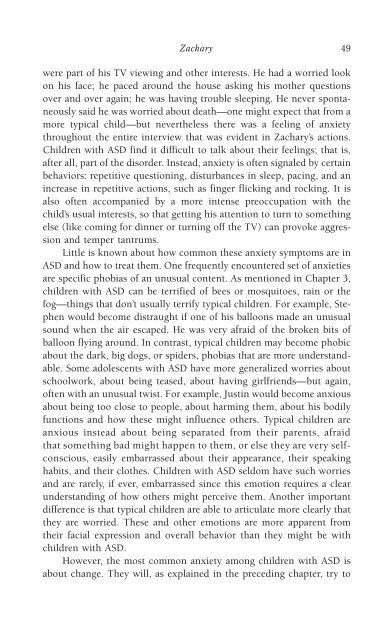978-1572305441
autism
autism
Create successful ePaper yourself
Turn your PDF publications into a flip-book with our unique Google optimized e-Paper software.
Zachary 49<br />
were part of his TV viewing and other interests. He had a worried look<br />
on his face; he paced around the house asking his mother questions<br />
over and over again; he was having trouble sleeping. He never spontaneously<br />
said he was worried about death—one might expect that from a<br />
more typical child—but nevertheless there was a feeling of anxiety<br />
throughout the entire interview that was evident in Zachary’s actions.<br />
Children with ASD find it difficult to talk about their feelings; that is,<br />
after all, part of the disorder. Instead, anxiety is often signaled by certain<br />
behaviors: repetitive questioning, disturbances in sleep, pacing, and an<br />
increase in repetitive actions, such as finger flicking and rocking. It is<br />
also often accompanied by a more intense preoccupation with the<br />
child’s usual interests, so that getting his attention to turn to something<br />
else (like coming for dinner or turning off the TV) can provoke aggression<br />
and temper tantrums.<br />
Little is known about how common these anxiety symptoms are in<br />
ASD and how to treat them. One frequently encountered set of anxieties<br />
are specific phobias of an unusual content. As mentioned in Chapter 3,<br />
children with ASD can be terrified of bees or mosquitoes, rain or the<br />
fog—things that don’t usually terrify typical children. For example, Stephen<br />
would become distraught if one of his balloons made an unusual<br />
sound when the air escaped. He was very afraid of the broken bits of<br />
balloon flying around. In contrast, typical children may become phobic<br />
about the dark, big dogs, or spiders, phobias that are more understandable.<br />
Some adolescents with ASD have more generalized worries about<br />
schoolwork, about being teased, about having girlfriends—but again,<br />
often with an unusual twist. For example, Justin would become anxious<br />
about being too close to people, about harming them, about his bodily<br />
functions and how these might influence others. Typical children are<br />
anxious instead about being separated from their parents, afraid<br />
that something bad might happen to them, or else they are very selfconscious,<br />
easily embarrassed about their appearance, their speaking<br />
habits, and their clothes. Children with ASD seldom have such worries<br />
and are rarely, if ever, embarrassed since this emotion requires a clear<br />
understanding of how others might perceive them. Another important<br />
difference is that typical children are able to articulate more clearly that<br />
they are worried. These and other emotions are more apparent from<br />
their facial expression and overall behavior than they might be with<br />
children with ASD.<br />
However, the most common anxiety among children with ASD is<br />
about change. They will, as explained in the preceding chapter, try to



